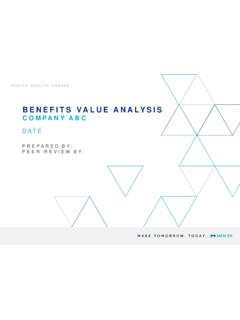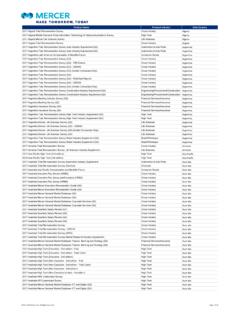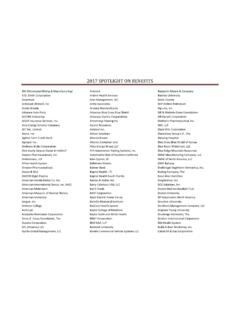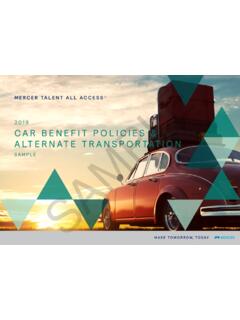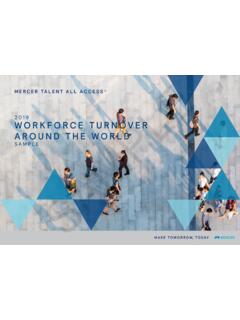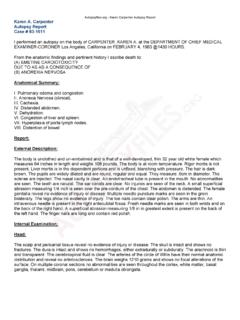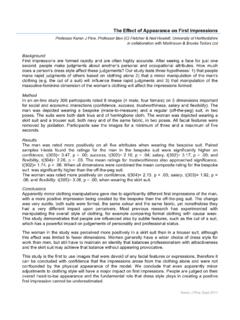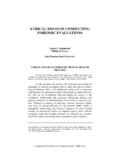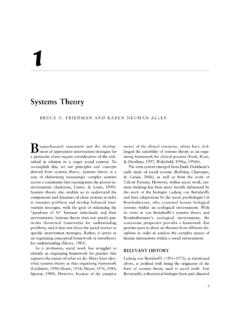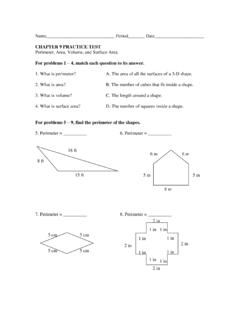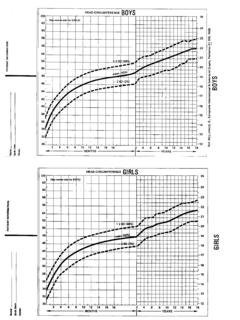Transcription of HR STRUCTURES TODAY - imercer
1 HR STRUCTURES TODAYBy Mercer s karen Shellenback 50% of HR organizations TODAY use centralized OF CENTRALIZED, HYBRID, AND DECENTRALIZED HR MODELS HOW IS HR STRUCTURED TODAY ?How is HR structured across the globe in 2017? What HR service delivery models and practices drive the most value? At the end of 2016, Mercer Select Intelligence and the Mercer HR Transformation consulting practice deployed research to find out. This short report provides HR executives with the data to compare their current HR structure to that of their peers. The report focuses on two elements of HR STRUCTURES : their degree of centralization and their use of the prevailing model of Centers of Excellence (COEs), HR Shared Services (HRSS), and HR Business Partners (HRBPs). This report will also indicate how high performing HR organizations are structured and the kinds of organizations that are planning structural changes to their HR model in the next 18 , DECENTRALIZED OR SOMEWHERE IN THE MIDDLE?
2 Centralized HR organizational STRUCTURES help drive efficiency and consistency of processes across the organization and centralization is relied on in HR business models TODAY . Half of HR organizations (50%) are centralized, and very few organizations (15%) report that they are decentralized. The remaining 35% use a hybrid model with some decisions and policies deployed commonly across the organization, and some locally. fDECENTRALIZED: Administration and decisions made at the local level. Policies and practices vary significantly across field locations. No centralized HR support or administration activities. fHYBRID: Half centralized, half decentralized HR structure , decisions, policy deployment, and administration. fCENTRALIZED: Administration and decisions are centralized. Policies and practices do not vary across field locations. Fully centralized HR support or administration OF CENTRALIZATION BY EMPLOYER SIZE What is the impact of employer size on degree of centralization?
3 The use of centralized HR organizational STRUCTURES is most prevalent in employers with 250-999 employees. Furthermore, eight in ten small employers with 500 999 employees use a centralized model. However, centralized STRUCTURES are found in all employer sizes and a smaller employer size does not seem to dictate increased OF CENTRALIZATION BY EMPLOYER SIZEDECENTRALIZEDCENTRALIZEDHYBRIDFEWER THAN 99 EMPLOYEES500-999 EMPLOYEES250-499 EMPLOYEES5,000-9,999 EMPLOYEES20,000 OR MOREEMPLOYEES1,000-4,999 EMPLOYEES100-249 EMPLOYEES10,000-19,999 EMPLOYEESDEGREE OF CENTRALIZATION BY EMPLOYER TYPE Does employer type impact degree of centralization? The centralized HR organizational structure is most prevalent in state-owned enterprises, nonprofits, NGOs (nongovernmental organizations), and government agencies, while for-profit organizations predominately use centralized and hybrid OF CENTRALIZATION BY EMPLOYER TYPESTATE-OWNED ENTERPRISE (CORPORATION OWNED OR IN PARTNERSHIP WITH THE GOVERNMENT)NONPROFIT, NGO (NONGOVERNMENTAL ORGANIZATION OR ACADEMIC INSTITUTION)
4 GOVERNMENT AGENCYPUBLICLY OWNED FOR-PROFIT ORGANIZATION13% 10% 20% 11% 18% 13% 25% 20% 38% 37% 75% 65% 60% 51% 45% PRIVATELY OWNED FOR-PROFIT ORGANIZATIONDECENTRALIZEDCENTRALIZEDHYBR ID21% 25% 13% 13% 8% 13% 12% 19% 50% 39% 29% 7% 42% 38% 47% 38% 29% 36% 58% 80% 50% 50% 41% 44% 2017 MERCER STRUCTURES TODAY2 DEGREE OF CENTRALIZATION BY GLOBAL REGION15% 12% 32% 12% 11% 30% 51% 14% 47% 45% 44% 20% 34% 74% 21% 43% 44% 50% GLOBALSOUTH AMERICANORTH AMERICAASIA PACIFICEUROPEMIDDLE EAST AND AFRICADEGREE OF CENTRALIZATION BY GLOBAL REGIONR egional differences also emerged in the study. The centralized structure dominates in North America, with three quarters of US and Canadian companies using it. However, for organizations that categorized themselves as global companies, over one-half reported that they use a hybrid structure . A hybrid structure often makes sense for large global and multinational companies given their need to balance large spans of control coupled with specific local requirements.
5 Interestingly, approximately one-third of companies in Latin America and the Middle East and Africa use a decentralized structure (2X more than the aggregate results). Perhaps this is due to cultural and legislative differences across the different countries that comprise Latin America, the Middle East, and 2017 MERCER STRUCTURES TODAY3 THE PREVAILING THREE ELEMENT MODEL TODAY s most prevalent HR structural model relies on three primary elements: HR Shared Services (HRSS), Centers of Expertise (COEs), and HR Business Partners (HRBPs). Participants in this research were asked to indicate whether they use all three elements of the prevailing model (HRSS, HRBPS, and COEs) or just one or two elements. Organizations that use of any of the individual three elements or any combination of the three elements were categorized as using the prevailing model. Organizations that use all three elements were categorized as using the full prevailing model and companies that don t use any of the three elements were defined as nonprevailing model.
6 The full prevailing model uses all three of the elements: fHRSS: Drives operational excellence by delivering customer service and administration of HR programs with a focus on efficiency, data, and technology. fCOEs: Design appropriate HR strategies, programs, policies, and processes. fHRBPs: Act as strategic partners and liaisons between the business and essence, the three elements of the full prevailing model work in tandem with HR leadership and HR technology to effectively design and deliver efficient transactional operations and business driven HR advisory services. THE PREVAILING HR OPERATING MODELHR LEADERSHIP TEAMP roviding HR strategy and execution to the business and ensuring the success of the HR operating model TECHNOLOGY ENABLEDHR Portal Telephony Case Management Knowledge Management HCMHR BUSINESS PARTNERS (HRBP)Acting as a strategic partners and liaison between the business and centers of expertiseFOCUS:Strategic AlignmentHR SHARED SERVICES (HRSS)Delivering customer service and administration of HR programs with a focus on efficiency, data and technologyFOCUS:Operational ExcellenceHR CENTERS OF EXPERTISE (COE)Designing appropriate HR strategies, programs, policies and processesFOCUS:Program Design 2017 MERCER STRUCTURES TODAY4 SELECTED USE OF THE THREE ELEMENTS In practice the extent to which the three elements COEs, HRBPs, and HR Shared Services are deployed differs.
7 Only one-half (54%) of companies who report using the prevailing model leverage all three elements (the full prevailing model). Three out of 10 (31%) use two elements, but another 15% use only one. This research indicates, however, that high-performing HR functions leverage all three components of the full prevailing OF THE 3 ELEMENTS5% 7% 3% 6% 6% 19% 54% S S O N LYSS AND COEHRBP ONLYHRBP AND COECOE ONLYSS AND HRBPALL THREE (FULL PREVAILING MODEL)Organizations that employ an HR service delivery model with any combination of HRBPs, COEs, and , of those organizations that employ the prevailing model (64%), 85% leverage HRBPs, 82% use COEs but only 70% employ OTHER TWO BURNING QUESTIONS: WHO REPORTS TO WHOM? WHO DOES HR REPORT TO? 7 out of 10 times (69%) the CHRO reports to the DOES PAYROLL REPORT TO? Payroll reports to HR 65% of the time. Only 27% of companies require that payroll report into finance.
8 Use of finance for payroll increases with centralization, and does not decrease as employer size increases. Significantly, 71% of high performing HR organizations deploy all three elements of the prevailing model: COEs, HRBPs, and HR Shared Services. 2017 MERCER STRUCTURES TODAY5 TENURE AND MATURITY Although the prevailing HR model has been advocated by HR gurus and practitioners for over 15 years, it is interesting to note that most (72%) organizations have had the prevailing model in place less than five MODEL PREVALENCE BY TENUREIn fact, two out of ten HR organizations that report that they use the prevailing model indicate that they are in start-up mode and another 30% indicate that they are in the growth MODEL PREVALENCE BY STAGESTART-UP We are just starting to transform our HR service delivery to a prevailing Our shared services center is effective and efficient.
9 We are focused on redefining and expanding capabilities and roles of our HR leadership, COE, and/or senior HRBP staff. We are focused on building a robust HR analytics We are in a growth phase, have established (or mostly established) a workable shared services model and are building COE and HRBP capabilities and We have mastered most of the day-to-day HR service delivery challenges. Our technology is state of the art and efficient. We continue to build our HR analytics capacity by using predictive analytics. We focus on continuous HR operational STA BL I S HED We have been established as a prevailing model for some time, but are continually tweaking our processes, practices, and technology for efficiencies and to drive additional HR customer value. Employees and managers know where to go for HR We are looking for a new HR service delivery model and are transforming our HR out of the prevailing model in the next 18 months.
10 1%4 5 19 36 24 12 LESS THAN ONE YEAR3-5 YEARS1-2 YEARS6-10 YEARS11-20 YEARS20 PLUS YEARS 36% of companies with the prevailing model have redesigned their service delivery structure within the last 3 5 years. 2017 MERCER STRUCTURES TODAY6In fact, analyzing the stage of development by age of the model reveals a predictable pattern. HR organizations with the youngest models report that they are mostly in start-up or growth phases, while organizations with older HR models are most likely in the established, expansion, and mature stages. Furthermore, those organizations that are high-performing are more likely in the growth, established, or expansion stages of the model (87%). This may be due to the fact that becoming a high-performing HR organization requires time and experience to work out the implementation phase and inherent kinks in the model. It is also noteworthy that the two organizations that plan on exiting the prevailing model have had the model in place between 6-10 years.
